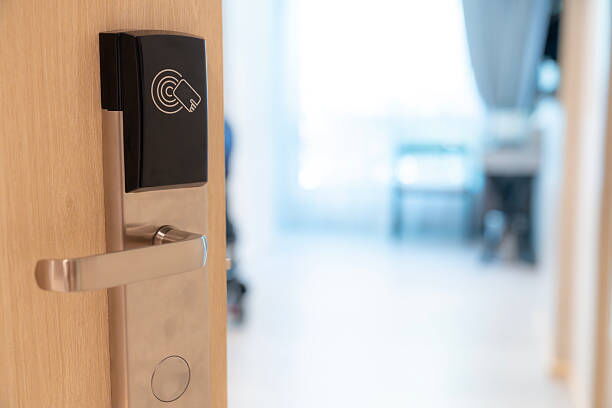Access control has become a defining factor in how we secure our homes, offices, and shared community spaces. With growing demand for safety, convenience, and efficiency, traditional locks and keys are increasingly giving way to more advanced systems. One of the most widely adopted technologies in this space is RFID door locks.
RFID (Radio Frequency Identification) door locks simplify the process of managing access by using electronic credentials such as key fobs or cards, replacing outdated mechanical keys. While these locks are efficient at managing access for individual tenants, most modern properties — especially residential complexes and commercial facilities — require more comprehensive solutions. With multiple entrances, shared amenities, and a constant flow of couriers, service providers, and guests, a simple tenant-only access solution is no longer enough.
That is where RFID door locks fit into a larger ecosystem of smart locks, keypads, and smartphone-based intercom systems. When combined into a unified access control solution, these tools not only streamline property management but also enhance convenience for residents and visitors alike.
This news piece explores RFID door locks in depth — what they are, how they work, their benefits, essential components, FAQs, and their role in the future of access control.

At its core, an RFID door lock is an electronic lock that allows entry through a credential programmed with specific data. These credentials, often in the form of cards or key fobs, communicate wirelessly with a reader using RFID technology.
RFID technology uses electromagnetic fields to establish communication between two devices:
Tags: Small chips embedded in cards, fobs, or even smartphones that carry digital identity data.
Readers: Devices that scan the tag and transfer the data to the system’s control panel.
This same technology is used in logistics to track packages and vehicles, in agriculture to identify livestock, and even in retail to manage inventory. In access control, RFID’s wireless and contactless capability has made it a reliable and flexible alternative to mechanical locks.
An RFID system is made up of several integral parts, each playing a role in ensuring seamless and secure entry.
The tag acts as the identity carrier. It stores a unique digital code linked to the user. Typically, tags are embedded in access cards, key fobs, or in some cases, even smartphones equipped with NFC (near-field communication) technology.
The reader is the interface point. When a resident presents their card or fob, the reader captures the information via its antenna and sends it to the control panel for validation.
Think of this as the brain of the system. The control panel maintains a database of authorized credentials. When a tag is scanned, it checks whether the data matches. If validated, the system triggers the lock mechanism to open. Administrators can easily update the database to grant or revoke access as residents move in, move out, or lose credentials.
RFID door locks function much like smart locks but rely specifically on radio wave communication. Here’s the process in action:
Credential Assignment: The property manager programs a card, fob, or smartphone with a unique digital identity.
Access Attempt: The user taps or waves their credential near the RFID reader.
Data Verification: The reader sends the stored code to the control panel for comparison.
Decision: If the credential matches the database, the lock disengages. If not, access is denied.
Revocation & Updates: In case a card is lost or a tenant vacates, administrators can instantly deactivate credentials — no need to replace the entire lock.
This system ensures both security and flexibility, with minimal physical interaction.
RFID door locks offer a wide range of advantages that make them popular in both residential and commercial applications.
Traditional keys can be easily duplicated, but RFID credentials are much harder to copy. Plus, lost or stolen cards can be deactivated instantly, reducing risks of unauthorized entry.
Users no longer need to carry bulky keychains. A single card or fob can grant access to multiple areas. In hotels, guests can check in with a card that opens their room, elevators, and fitness centers.
Administrators can grant temporary or restricted access to visitors, service providers, or couriers without handing over permanent keys. This is especially useful for properties with high visitor traffic.
Compared to mechanical systems that require lock replacement when keys are lost, RFID systems only need credential reprogramming, saving time and money.
RFID locks can be installed on a variety of doors and even integrated with furniture or cabinet locks, making them versatile for both residential and office applications.
The seamless, contactless entry process provides a smoother and faster experience, especially valuable in high-turnover environments like hotels, dormitories, and co-working spaces.
While RFID door locks are highly beneficial, it’s worth noting a few considerations:
Initial Setup Costs: Installing RFID systems requires an upfront investment in readers, control panels, and credentials.
Credential Misuse: Though difficult, RFID credentials can still be cloned if security protocols aren’t strong.
Power Dependency: As electronic systems, they rely on a constant power supply or battery backup.
These limitations are generally outweighed by the long-term security and convenience benefits, especially in multi-unit and commercial properties.
RFID door locks are not limited to apartment complexes. They are widely used across different industries:
Hospitality: Hotels rely heavily on RFID cards to manage guest room access. Cards can be deactivated after checkout.
Corporate Offices: Employees use RFID badges to enter secured workspaces and even operate elevators.
Educational Institutions: RFID locks secure dormitories, labs, and administrative buildings.
Healthcare Facilities: Hospitals use them to restrict access to sensitive areas like pharmacies and labs.
Residential Communities: Homeowners and tenants enjoy seamless access to individual units and common amenities.
The evolution of RFID door locks represents a major step forward in access control, but innovation continues. Increasingly, RFID systems are integrated with smartphones, biometrics, and cloud-based platforms to create seamless ecosystems.
Mobile Credentials: Residents can unlock doors using their smartphones via NFC or Bluetooth, eliminating the need for physical cards.
Biometric Integration: Fingerprint and facial recognition add an extra layer of identity verification.
IoT and Cloud Platforms: Administrators can monitor and manage access remotely, viewing logs in real time and making instant updates.
As urbanization grows and security demands rise, RFID door locks — as part of comprehensive smart access solutions — will remain central to shaping secure, connected living and working environments.
RFID door locks have emerged as a practical and reliable alternative to traditional locks, offering enhanced security, flexibility, and convenience. They empower property managers to streamline operations while giving residents greater control over their access experience.
Whether used in apartments, offices, hotels, or hospitals, RFID technology delivers the balance between security and ease of use that modern life demands. As these systems evolve with integration into smartphones, biometrics, and cloud technologies, the role of RFID door locks will only become more significant in the years ahead.
For properties that need more than just tenant-level access, RFID door locks — when combined with smart locks, video intercoms, and keypads — provide a unified solution that saves time, reduces costs, and ensures safety for everyone.
Q1: How to Unlock an RFID Door Lock?
There are multiple methods depending on the system setup:
Master Key or Card: Administrators may carry a master credential that overrides other codes.
Wireless Key Fob: A programmed fob can quickly unlock the door.
Magnetic Overrides: Some locks allow emergency unlocking using magnetic tools, though these are restricted to authorized personnel.
Q2: How to Install an RFID Door Lock?
Installation is straightforward:
Remove the old mechanical lock.
Install the RFID-enabled lock hardware.
Connect the power supply (battery or wired).
Program the lock with desired access codes and credentials.
Most modern RFID locks are designed for quick retrofitting, minimizing downtime.
Q3: What Happens if Power Fails?
Many RFID door locks come with battery backups or mechanical override keys to ensure accessibility during outages.
Q4: Are RFID Locks Hack-Proof?
No system is 100% hack-proof. However, advanced encryption, secure databases, and regularly updated software make RFID locks significantly more secure than mechanical keys.
Q5: How secure are RFID door locks?
RFID door locks are considered highly secure due to their use of advanced encryption technologies, such as AES, to protect stored data and communication between the credential and reader. Each unlocking action requires the correct digital key, making unauthorized access extremely difficult. Unlike traditional mechanical locks, which can be easily duplicated or picked, RFID systems provide a stronger defense against tampering and duplication. Even if the physical lock body is dismantled, the encrypted data inside cannot be directly accessed or exploited, further enhancing security. Additionally, administrators can quickly deactivate lost or stolen cards, eliminating risks that come with misplaced keys. These features make RFID door locks a reliable choice for residential, commercial, and hospitality settings where both convenience and safety are top priorities. By combining strong encryption, contactless access, and flexible control, RFID locks offer a modern and secure solution for today’s access control needs.
